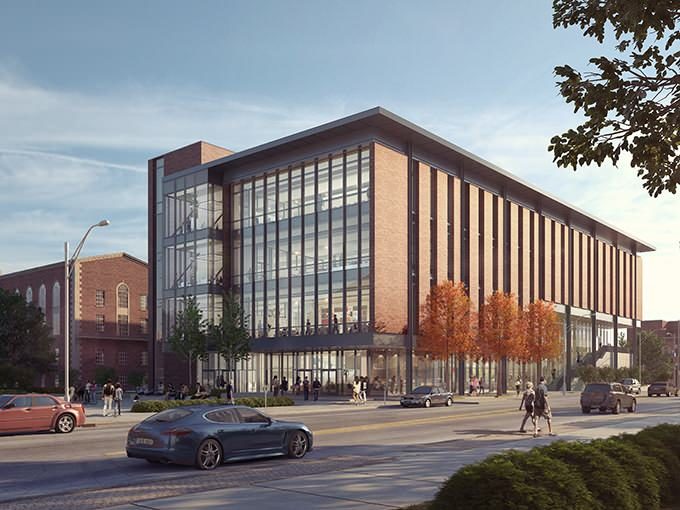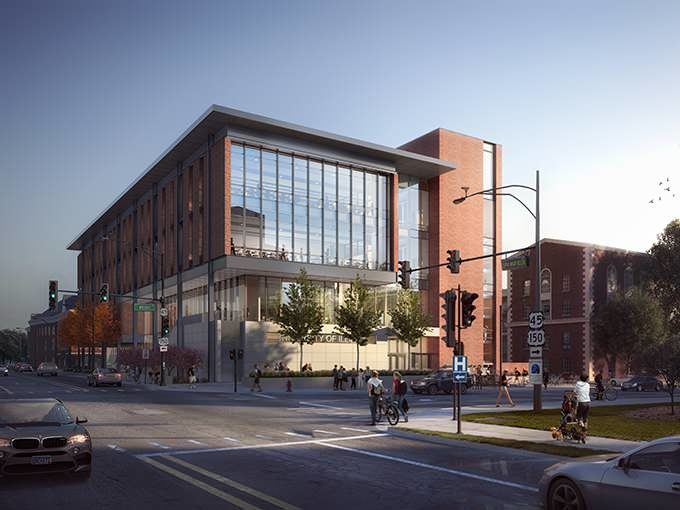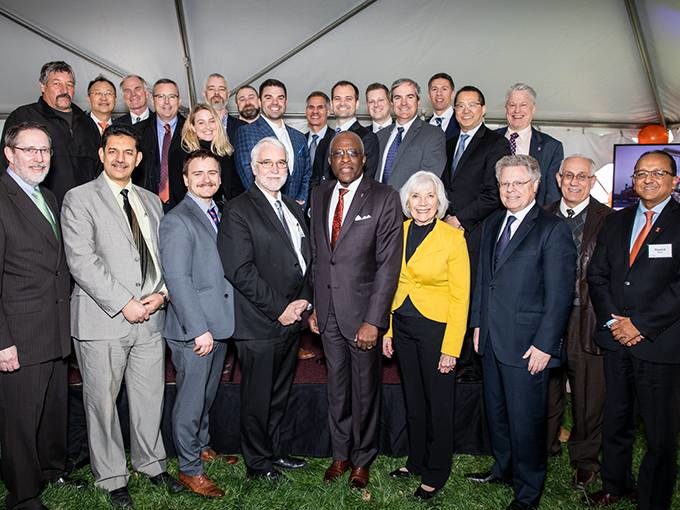



On Friday, April 12th, the University of Illinois at Urbana-Champaign Chancellor Robert Jones joined local academic and civic leaders to break ground on the Campus Instructional Facility. Designed by Skidmore, Owings & Merrill LLP (SOM), the building will feature a diverse combination of open-concept, flexible, and future-focused learning and collaboration spaces to accommodate the changing needs of the university, its students, and its faculty.
“The University of Illinois at Urbana-Champaign provides a world-class education for our students,” said Chancellor Jones. “The Campus Instructional Facility Project will ensure that we continue to create learning environments that inspire collaboration and interactive education for our students. We believe this facility will be a catalyst for innovation and creativity.”
Located adjacent to the main engineering quadrangle at Springfield Avenue and West Wright Street, the building will serve as a central hub for contemporary teaching and learning for the university, incorporating an array of customized spaces designed to enhance collaboration between students and faculty, and introduce new technologies for hands-on learning. Celebrating the university’s mission to cultivate research and discovery, the building includes flexible classrooms and reconfigurable spaces designed to evolve as needs change on campus.
“The design of the Campus Instructional Facility blends the rich history of the University of Illinois with its progressive, technology-focused approach to learning. In designing the building, we sought to celebrate the intersection of architecture and engineering, while creating an environment where experimentation and invention could thrive,” said Brian Lee, Design Partner.
“SOM was built on the importance of collaboration between architects and engineers, and that spirit continues to be championed today. We are thrilled to have the opportunity to create a home for interdisciplinary learning and have an impact on the education of future students,” added William F. Baker, Structural Engineering Partner, and University of Illinois Engineering alumnus.

Image © SOM | Smilodon
The building’s structure and architecture are carefully integrated, with exposed structural steel elements supporting the building’s architectural massing throughout the interior and exterior. Collaboration hubs on each floor encourage informal gathering, bolstered by a multi-story gathering staircase framed by soaring structural trusses, which extend from floor to ceiling and connect with floors above. Designed to respect and complement the scale and materiality of surrounding buildings, the building is clad in brick and curtains of glass, maximizing natural lighting and enhancing views.
The 122,000-square-foot, four-story building includes a variety of spaces to accommodate lecture, active learning, classroom, collaboration, individual study, and social environments. A central circulation spine anchors the building’s public spaces, allowing views across all floors and overlooking the engineering quadrangle, Grainger Library, and the north-south pedestrian axis. A 60-foot long-span space with flexible partitions accommodates large class configurations while small classrooms are distributed along the building’s core. A 500-seat auditorium is located in the basement. The building’s 23 active learning and traditional classrooms range in capacity from 24 to 500 students.
The building is designed to meet significant sustainability goals, with features that include geothermal and radiant heating and cooling, improved air quality through low VOC materials, and dynamic glazing to mitigate solar gain on the east and west facades. The building is targeting LEED Gold certification and will perform 54% above the ASHRAE standard and 77% above the Commercial Building Energy Consumption Survey standard.
Classes from throughout the campus will be held inside the building, with an emphasis on active-learning spaces, distance-learning environments, and cutting-edge innovation technology. The University of Illinois will use the facility and its specialized spaces to support programs like Engineering City Scholars, Professional Masters Programs in Engineering, and The Academy for Excellence in Engineering Education, among others.
Targeting completion in 2021, the building will be realized through a public-private partnership, the first of its kind for the University of Illinois system. SOM has partnered with Vermilion Development, Campbell Coyle, and Pepper Construction to complete the project.
About Skidmore, Owings & Merrill LLP
Skidmore, Owings & Merrill LLP (SOM) is one of the leading architecture, interior design, engineering, and urban planning firms in the world. Since its founding more than 80 years ago, SOM has earned a reputation for design excellence with a portfolio that includes some of the most important architectural accomplishments of the 20th and 21st centuries, and has been a leader in the research and development of specialized technologies, new processes and innovative ideas, many of which have had a palpable and lasting impact on the design profession and the physical environment. The firm’s longstanding leadership in design and building technology has been honored with nearly 2,000 awards for quality, innovation, and management. The American Institute of Architects has recognized SOM twice with its highest honor, the Architecture Firm Award—in 1962 and again in 1996. The firm maintains offices in New York, Chicago, San Francisco, Los Angeles, Washington, D.C., Seattle, London, Hong Kong, Shanghai, Dubai, and Mumbai.
About The University of Illinois at Urbana-Champaign
The University of Illinois Urbana-Champaign is one of the world’s pre-eminent institutions of higher education. A member of the Association of American Universities and one of the most productive research organizations in the world, the university boasts discoveries, ideas, and approaches that have changed the way the world works, communicates, conducts business, creates art, and solves problems.